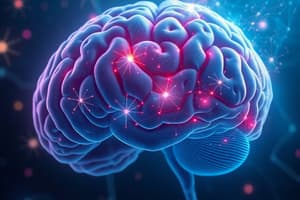Podcast
Questions and Answers
Which lobe of the cerebral cortex is responsible for higher mental functions?
Which lobe of the cerebral cortex is responsible for higher mental functions?
- Occipital lobe
- Temporal lobe
- Frontal lobe (correct)
- Parietal lobe
Which lobe of the cerebral cortex integrates sensory information from different modalities?
Which lobe of the cerebral cortex integrates sensory information from different modalities?
- Parietal lobe (correct)
- Frontal lobe
- Temporal lobe
- Occipital lobe
Which lobe of the cerebral cortex is responsible for auditory perception, semantics, and memory?
Which lobe of the cerebral cortex is responsible for auditory perception, semantics, and memory?
- Frontal lobe
- Temporal lobe (correct)
- Parietal lobe
- Occipital lobe
Which lobe of the cerebral cortex is the visual processing center?
Which lobe of the cerebral cortex is the visual processing center?
Which artery supplies blood to the frontal lobe?
Which artery supplies blood to the frontal lobe?
Which type of somatic sensation is stimulated by mechanical displacement?
Which type of somatic sensation is stimulated by mechanical displacement?
Where are Meissner corpuscles primarily located?
Where are Meissner corpuscles primarily located?
Which type of nerve fibers are associated with Merkel discs?
Which type of nerve fibers are associated with Merkel discs?
What is the function of Pacinian corpuscles?
What is the function of Pacinian corpuscles?
Which type of nerve fibers are associated with free nerve endings?
Which type of nerve fibers are associated with free nerve endings?
Which type of transmitter is usually excitatory in the CNS and accounts for more than 90% of the synaptic connections?
Which type of transmitter is usually excitatory in the CNS and accounts for more than 90% of the synaptic connections?
What is the function of dendrites in stimulating neurons?
What is the function of dendrites in stimulating neurons?
What is synaptic facilitation?
What is synaptic facilitation?
What is the mechanism behind synaptic fatigue?
What is the mechanism behind synaptic fatigue?
What is the effect of acidosis on neuronal activity?
What is the effect of acidosis on neuronal activity?
Which system contains large myelinated nerve fibers and transmits touch and vibration with a high degree of spatial fidelity?
Which system contains large myelinated nerve fibers and transmits touch and vibration with a high degree of spatial fidelity?
Which system contains smaller myelinated and unmyelinated fibers for slow transmission and transmits a broad spectrum of modalities including pain and thermal sensations?
Which system contains smaller myelinated and unmyelinated fibers for slow transmission and transmits a broad spectrum of modalities including pain and thermal sensations?
Which system maintains a high degree of spatial orientation throughout the tract and decussates in the medulla oblongata?
Which system maintains a high degree of spatial orientation throughout the tract and decussates in the medulla oblongata?
Which system has a low degree of spatial orientation, decussates in the spinal cord, and transmits a broad spectrum of modalities including crude touch and pressure?
Which system has a low degree of spatial orientation, decussates in the spinal cord, and transmits a broad spectrum of modalities including crude touch and pressure?
Which part of the cortex receives information from the opposite side of the body and has unequal representation of the body?
Which part of the cortex receives information from the opposite side of the body and has unequal representation of the body?
Which type of sensory receptor detects damage (pain receptors)?
Which type of sensory receptor detects damage (pain receptors)?
What is the term used to describe the principle that each receptor responds to a limited range of stimuli and has a direct line to the brain?
What is the term used to describe the principle that each receptor responds to a limited range of stimuli and has a direct line to the brain?
What generates receptor potentials through mechanical deformation?
What generates receptor potentials through mechanical deformation?
Which type of receptor adapts slowly and continues to transmit impulses to the brain for long periods of time while the stimulus is present?
Which type of receptor adapts slowly and continues to transmit impulses to the brain for long periods of time while the stimulus is present?
What is the term used to describe the transmission of receptor information to the brain by different types of neurons?
What is the term used to describe the transmission of receptor information to the brain by different types of neurons?
Which part of the nervous system is responsible for responding to and moving about in our environment?
Which part of the nervous system is responsible for responding to and moving about in our environment?
Which level of CNS function controls subconscious body activities such as arterial pressure, respiration, and feeding reflexes?
Which level of CNS function controls subconscious body activities such as arterial pressure, respiration, and feeding reflexes?
What is the main body of a neuron called?
What is the main body of a neuron called?
Which neurotransmitter is the chief excitatory transmitter in the CNS?
Which neurotransmitter is the chief excitatory transmitter in the CNS?
What type of summation occurs when EPSPs created by distant synapses overlap?
What type of summation occurs when EPSPs created by distant synapses overlap?
Which part of the nervous system is responsible for responding to and moving about in our environment?
Which part of the nervous system is responsible for responding to and moving about in our environment?
What are the three major levels of CNS function?
What are the three major levels of CNS function?
Which neurotransmitter is the chief excitatory transmitter in the CNS?
Which neurotransmitter is the chief excitatory transmitter in the CNS?
What type of summation occurs when EPSPs created by distant synapses overlap?
What type of summation occurs when EPSPs created by distant synapses overlap?
Which neurotransmitter opens Cl channels and is the chief inhibitory transmitter in the adult CNS?
Which neurotransmitter opens Cl channels and is the chief inhibitory transmitter in the adult CNS?
Flashcards are hidden until you start studying




